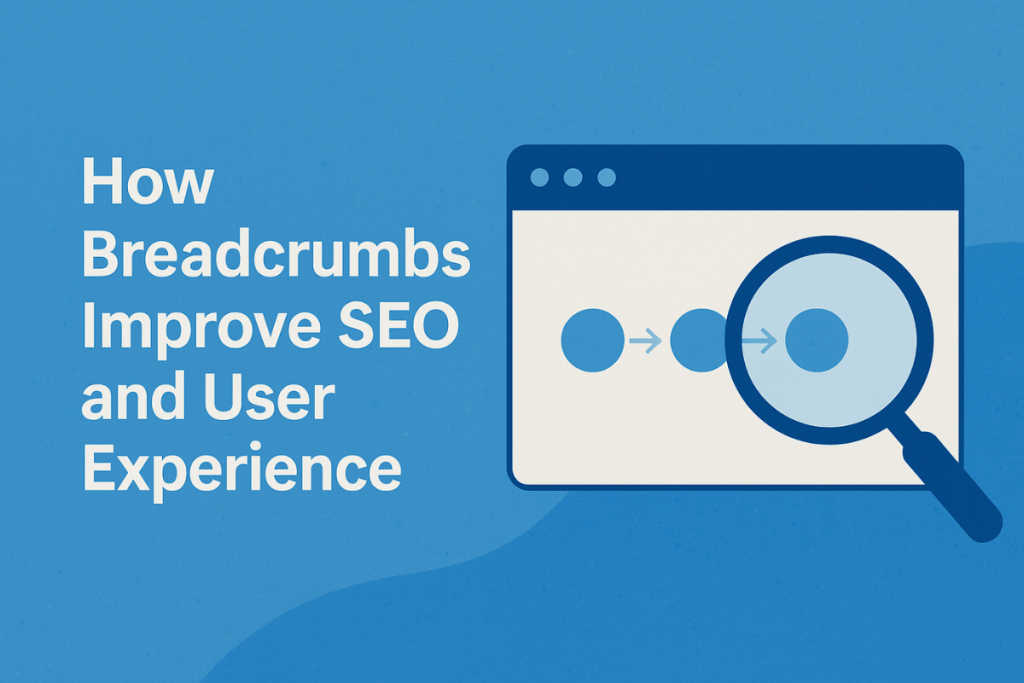Creating great content isn’t the only way to rank on SERPs. Users should also be able to access and navigate your content. Making your website SEO-friendly involves making it easily understandable to both search engines and real users. Breadcrumbs are an extremely powerful tool that can help get you there. In this blog, we explore how breadcrumbs improve SEO and user experience.
What are Breadcrumbs?

Breadcrumbs are UI elements that are represented as a small text path near the top of a webpage. They are automated internal links that help users track their location on a website in relation to the site’s home page.
Breadcrumbs can be of four types:
1) Hierarchy-based (location-based, showing site structure)
2) History-Based Breadcrumbs (path-based, showing user history)
3) Attribute-based (showing selected filters)
4) Forward Or Look-Ahead Breadcrumbs (showing preview of next steps)
Advantages Of Using Breadcrumbs
Breadcrumbs can be an extremely underrated yet useful addition to your website. Using breadcrumbs has several advantages:
Helps Google Crawlers
Perhaps one of the most useful features of breadcrumbs is that they help Google crawlers understand which pages are more important than others. They do this by creating a hierarchical structure that clearly differentiates categories and subpages. In this way, breadcrumbs help Google understand your website and its purpose.
Enhances User Experience
Breadcrumbs are a powerful SEO strategy that can improve the user experience (UX) by making your website easier to navigate. When your site is user-friendly, users want to spend more time on your site browsing products and pages.
Breadcrumbs help users navigate quickly and easily and reduce confusion by adding a recognizable interface to all pages. It also helps them understand their current location on your websites.
Lowers Bounce Rate
Users can land on your website via any page. When they do, they might want to explore a similar page or may need content that is on other parts of your website. Breadcrumbs are a reliable way to help such users navigate from their entry point to other pages on the website.

For example, a user landed on Myntra by searching ‘kurta sets for women’. If they change their mind and want to search only for kurtis instead, they can quickly change the category through the clickable breadcrumb links instead of creating a new search query.
When users find what they’re looking for quickly and conveniently, they’re less likely to leave your website. This is how breadcrumbs reduce your site’s bounce rate. When bounce rate reduces, engagement increases, and this helps your SERP rankings.
Improves SEO
Breadcrumbs improve your website’s search engine crawlability by helping search engines clearly understand your site structure. It also improves your website’s internal linking by ensuring that all your pages are linked to each other.
Google also prefers showing breadcrumbs in search snippets instead of your URL. For example, in the above screenshot, it shows users “Home > PRP treatment” instead of the entire URL “https://www.dypatilivfcenter.com/prp-treatment.html.”
Why Don’t All Websites Use Breadcrumbs?
Websites with multi-level structures that have multiple products, categories, and sub-categories benefit tremendously from breadcrumbs. They can help users navigate the categories seamlessly and make the process of shopping much easier, which makes them an important part of ecommerce SEO.
While breadcrumbs certainly are a powerful SEO strategy, they don’t work for all websites. Ultimately, whether you use breadcrumbs or not will depend on the structure of your website. Breadcrumbs aren’t necessary for smaller websites, especially if all pages can be easily accessed from the home page.
Conclusion
Breadcrumbs contribute a lot to both SEO and user experience. They have a lot of advantages, such as making site navigation easier and helping search engines understand your website. However, they can actually be tricky to implement. Even deciding on the best type of breadcrumbs for your site can be confusing.
That’s where we come in. At Apex Infotech, we know how to make your website rank by using SEO services and UX best practices. Contact us for a comprehensive SEO audit today.
How many types of breadcrumbs are there?
There are four main types of breadcrumbs: hierarchy-based breadcrumbs, history-based breadcrumbs, attribute-based breadcrumbs, and look-ahead breadcrumbs.
What happens when you click on a breadcrumb?
Clickable breadcrumbs are internal links that help users navigate. Clicking on a breadcrumb sends you back to the page you clicked on without having to navigate to it by using the browser’s back button.
Are breadcrumbs essential for SEO?
If your website has a lot of sub-pages and categories, breadcrumbs are a must to help users navigate without confusion. They also have important SEO benefits.
Can breadcrumbs be your primary form of navigation?
No, breadcrumbs should never be your primary form of navigation. Users should have another form of primary navigation, like a menu bar, while breadcrumbs are used for secondary navigation.
Where does the word ‘breadcrumbs’ come from?
Breadcrumbs for SEO originate from the popular German fairytale of Hansel and Gretel, in which the children try to find their way out of a forest by following a trail of breadcrumbs.



